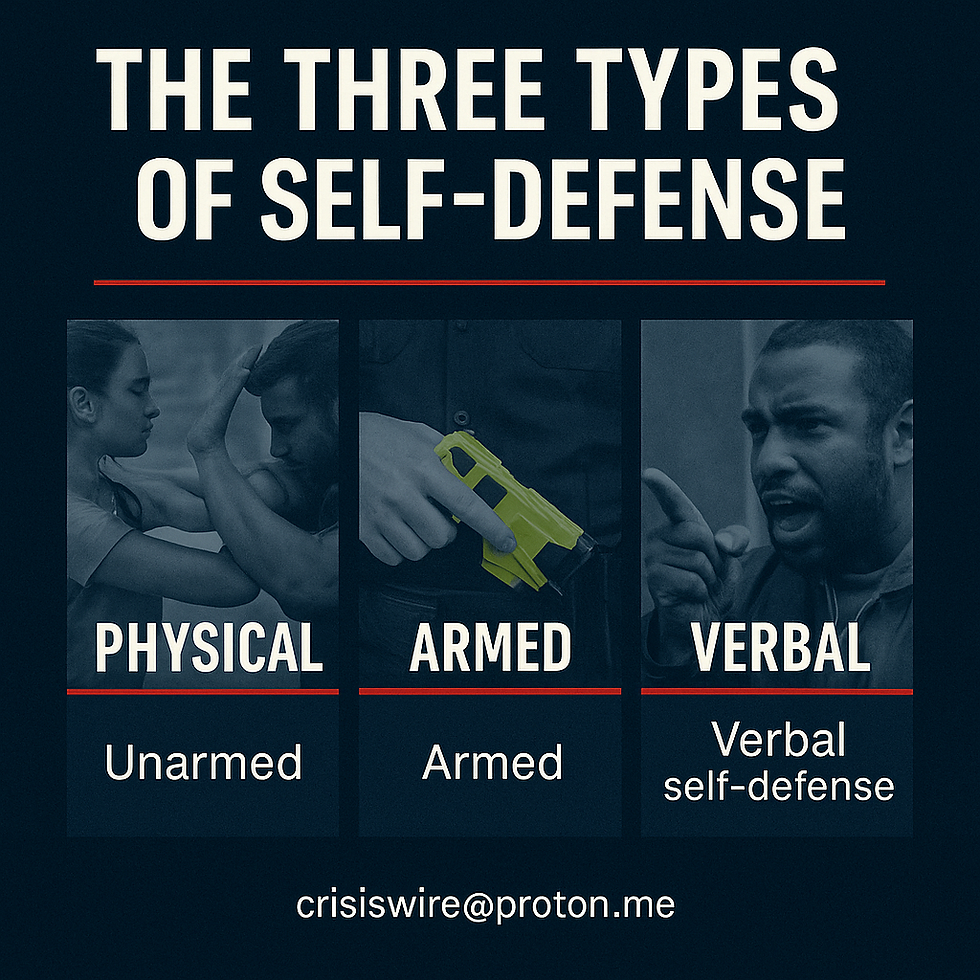The Three Types of Self-Defense Everyone Should Understand: Physical, Armed, and Verbal Protection
- CrisisWire

- Oct 3
- 2 min read
Why Self-Defense Matters in 2025
Self-defense isn’t just about fighting back — it’s about preparation, awareness, and survival. In a world where workplace violence, street crime, and personal threats are on the rise, knowing the three types of self-defense can give you the skills and confidence to stay safe.
As a USAF veteran, LAPD officer, and DHS/FEMA-certified threat management specialist, I’ve trained and relied on all three forms of self-defense: physical, armed, and verbal. Each has a place in your toolkit, and knowing when to use them can make the difference between escalation and safety.
1. Physical Self-Defense
Physical self-defense refers to using your body to protect yourself from harm.
This may include martial arts, defensive tactics, or escape techniques.
The goal is not aggression, but neutralizing a threat long enough to escape.
Effective training focuses on awareness, distance, and controlled response.
👉 CrisisWire Resource: Are School Safety Officers Police Officers?
2. Armed Self-Defense
Armed defense includes both lethal and non-lethal tools, from pepper spray and batons to firearms.
Non-lethal tools (pepper spray, Tasers, batons) provide protection without permanent harm.
Firearms are considered the highest form of armed defense but also carry the greatest responsibility and legal scrutiny.
Training, certification, and understanding use-of-force laws are critical.
👉 CrisisWire Resource: CrisisWire Services
3. Verbal Self-Defense
Sometimes the most powerful weapon is your voice.
Verbal self-defense (also called “conflict communication” or “de-escalation”) uses words, tone, and presence to defuse tension.
This includes setting boundaries, remaining calm, and using assertive but respectful communication.
Research shows verbal de-escalation is especially effective in schools, hospitals, and workplaces.
👉 CrisisWire Resource: Active Shooter Hoaxes: The New School Safety Menace

Why All Three Matter Together
The strongest self-defense strategy blends physical, armed, and verbal approaches:
Verbal → First line, prevents escalation.
Physical → Defensive last resort if attacked.
Armed → Tool for survival when escape is not possible.
Action Checklist: Building a Self-Defense Plan
Take a basic self-defense or martial arts course.
Carry a non-lethal self-defense tool and train with it.
Learn your state’s self-defense and use-of-force laws.
Practice verbal boundary setting and de-escalation.
Build situational awareness into your daily routine.
Leadership Responsibility
Schools, corporations, and security teams must recognize that self-defense training is both an individual right and an organizational responsibility. Leaders who invest in training and awareness programs reduce liability and protect their people.
Further Resources
FEMA – Emergency Preparedness
CISA – Cybersecurity & Infrastructure Security Agency
CrisisWire Blog – Security & Threat Assessment Resources
Want to strengthen your self-defense strategy? Contact CrisisWire Threat Management Solutions for training, audits, and consulting.📧 crisiswire@proton.me
#SelfDefense #CrisisWire #PersonalSafety #WorkplaceSafety #SchoolSafety #ThreatAssessment #NonLethalDefense #VerbalDeEscalation #ExecutiveProtection
FAQ
Q1: What is the difference between physical and verbal self-defense? Physical self-defense uses your body to block, escape, or counter an attack. Verbal self-defense uses communication skills to prevent escalation before it becomes physical.
Q2: Are non-lethal tools effective in armed self-defense? Yes. Tools like pepper spray and Tasers can incapacitate an attacker long enough to escape, without the permanent risks of firearms.
Q3: Do you need training for verbal self-defense? Yes — effective de-escalation takes practice. Security professionals, teachers, and healthcare staff benefit greatly from structured verbal defense training.





Comments